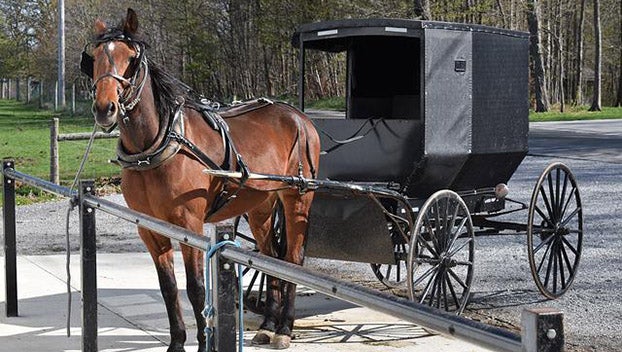Wastewater permit explained
Published 10:30 am Thursday, June 6, 2019
The Virginia Department of Environmental Quality (DEQ) announced a public comment period for a permit renewal for the Satchidananda Ashram-Yogaville Waste Water Treatment System located in Yogaville. The system would allow for a portion of treated wastewater to enter a portion of the James River.
“The applicant proposes to release treated sewage wastewaters from residential areas at a rate of 10,000 gallons per day into a water body,” the notice cited. “Sludge from the treatment process will be sent to the Lynchburg Regional Wastewater Treatment Plant.”
The comment period began May 15 and extends to June 14. Comments or questions can be directed to the Piedmont Regional Office: 4949-A Cox Road, Glen Allen, VA 23060, by phone at (804) 527-5046 and email at Adam.Eller@deq.virginia.gov.
Joseph Jeeva Abbate, with Yogaville Environmental Solutions, released a statement describing the wastewater treatment process in which wastewater is filtered and sanitized to minimize environmental impacts to the James River. Kyle Winter, with DEQ, provided information concerning the process as well.
Due to large-scale processes, such as the Atlantic Coast Pipeline (ACP) that have had permits considered by DEQ, curiosity led people to contact Yogaville about the permit. Abbate said he wanted to be transparent about the process and said the permit allows the system to meet state requirements.
“If we’re going to abide by good principals of environment and sanitation, then we have to have certain standards,” Abbate said. “DEQ has established the standards, and we are focused on abiding by it.”
HOW IT WORKS
The wastewater treatment system processes household waste from the guest and student facilities at Yogaville. The other facilities and residences operate on standard septic tank/ septic field systems, Abbate said.
“Our treatment facility processes material that results in about 5,000 gallons of treated and sanitized waste water per day,” Abbate said. “This is quite small compared to most commercial systems that are treating some millions of gallons per day. Our certified waste treatment plant is managed by a senior Yogaville employee who is certified as a waste treatment manager. That process and the resultant wastewater is monitored and tested 365 days per year, 24 hours per day, seven days per week.”
Abbate said the system has been in use for approximately 30 years and has not seen any issues. The activity of the wastewater plant is reported to the DEQ.
Abbate described wastewater as the water supply of a community after it has been soiled by use. He said it could contain human and household wastes, industrial wastes as well as groundwater and, in many cases, stormwater runoff.
“Before it can be safely returned to the environment, the wastewater must be treated,” Abbate said.
The treatment requires several steps, Winter and Abbate said.
The first step is preliminary treatment, Winter and Abbate said, in which wastewater flows into a treatment plant that screens out debris, such as plastics, that could damage the treatment plant.
Then, Winter said, “the wastewater is mixed in aeration tanks that already contain single-celled organisms that are cultivated in the tanks in a way similar to how yogurt, sourdough or kombucha are cultivated. We refer to this as ‘activated sludge.’”
The water itself is disinfected and filtered before it touches the river, Abbate and Winter said.
“These organisms consume the biodegradable materials in the wastewater as they go through their life cycles; the wastewater flows into another tank (the “clarifier”) where the activated sludge settles and is returned to the aeration tanks; the clear water is disinfected with chlorine, dechlorinated and discharged,” Winter said.
About the cleaned wastewater, Winter said, “at a design flow of 10,000 gallons per day (the actual flow is less than that), the discharge would look like you were pouring a soda can of water each second into a creek that flows down a steep hill into the James River.”
“After complete processing in Yogaville’s treatment plant, the treated and sanitized waste water flows into a small, isolated stream that flows for a mile, continuing the filtering and post-aeration of the water before entering the James River,” Abbate said. “Thus this liquid is treated, sanitized, aerated, and fully filtered before entering any stream or body of water, and prevents any harm or impact to our beautiful and pristine James River and its vibrant aquatic life.”
Concerning the sludge, Winter said, “as the single-celled organisms die off, it’s necessary to ‘waste’ some of the sludge that settles out in the clarifier. The wasted sludge is pumped into what’s called a ‘digester,’ which further breaks down the sludge. Rather than land-applying or landfilling the digested sludge, Yogaville has contracted a hauler to transport the sludge to the Lynchburg wastewater plant where it undergoes additional treatment.”
The design flow for the treatment plant is 10,000 gallons a day, though Winter said the actual flow is less than 10,000 gallons.
Yogaville has an additional wastewater plant that has a design flow of 1,000 gallons or less, Winter said. This discharges to the James River via a different creek and is covered under a general permit.
Abbate said the second wastewater treatment plant uses approximately 300 gallons in one of the buildings in Yogaville, which is filtered through sand and has been ultimately designed to be filtered and enter the river the same way as the other system, though in a smaller amount. Depending on the weather, dry conditions of the creek the treated wastewater discharges into prevented the treated wastewater in that plant from flowing into the James River.
“When it discharges in there, it’s not a flowing creek necessarily,” Abbate said. “It depends on the weather, whether there has been rain or not … if there has been no water running … like a septic field it would just leach through the sand and earth and then it wouldn’t reach. If that creek were running, it would run a similar length because it’s in our quad area, so it’s approximately a mile to the James.”
This plant has a different permit from the one receiving public comment.






